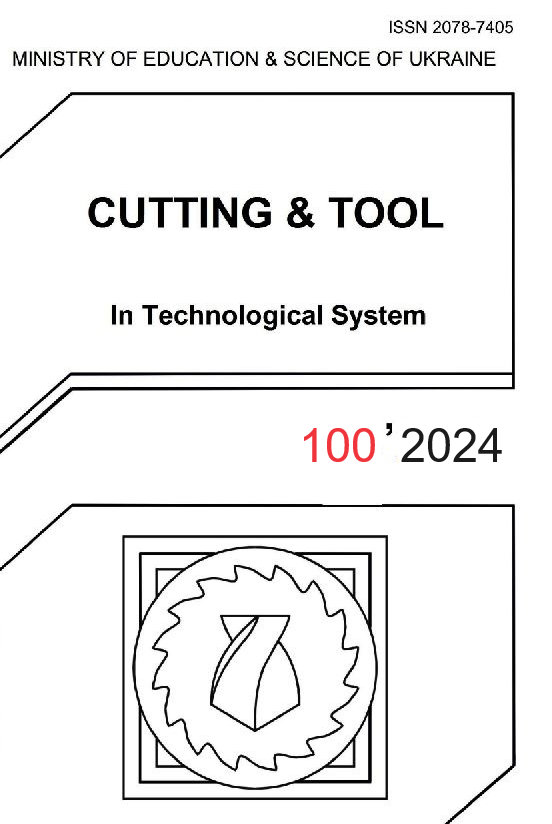SPECIFIC ENERGY CAPACITY OF PROCESSING AND ENERGY EFFICIENCY FOR PROCESS OF GRINDING WITH WHEELS FROM SUPERHARD MATERIALS
DOI:
https://doi.org/10.20998/2078-7405.2024.100.01Keywords:
specific energy capacity of grinding, energy efficiency coefficient, grinding;abrasive tool, wheel of the superhard materials, wear, frictionAbstract
The analysis of modern research shows that when evaluating the specific energy intensity of the abrasive processing process, one should pay attention not only to the indicators of grinding power and material removal rate, but also to the indicator of the wear of the abrasive tool, which we will show below for the grinding tool made of superhard materials. It is shown that the traditional method of estimating the specific energy capacity based on the ratio of the grinding power to the processing productivity does not provide an adequate solution, since with it the specific heat capacity of processing exceeds the specific heat capacity of melting of the processing material by almost an order of magnitude. Therefore, it is the application of a new approach to the assessment of the specific energy intensity of diamond grinding, taking into account the wear of the working layer of the diamond wheel, and makes it possible to estimate the indicators of the specific energy intensity of grinding and the energy efficiency coefficient. It has been proven that when estimating the specific energy capacity of grinding metal-ceramic composite materials consisting of a low-melting and refractory component, the latent heat capacity of melting of the low-melting component should be taken as the basis. It is shown that the plastic mode of grinding occurs precisely when the specific energy capacity of grinding, taking into account the wear of the wheel, becomes close to the specific heat capacity of melting of a brittle material.
References
Jianbiao Du, Hanzhong Liu, Ning Yang, Xiaozhou Chen, Wenjun Zong. Modification of diamond tool by focused ion beam in dry single-point diamond turning. Applied Surface Science. Volume 637,15 November 2023, 157882. https://doi.org/10.1016/j.apsusc.2023.157882.
Myronenko, E.V., Klymenko, H.P., Kalynychenko, V.V. Obshaja struktura matematicheskoj modeli dlja opredelenia energoefektivnich tehnologicheskih parametrov tokarnoi obrabotki detalei tjazhelogo mashinistroenia. Cutting&Tools in Technological System, 2015, Edition 85. pp. 202–210.
Lavrinenko,V.I. To the analysis of the estimate of energy expenditures in the diamond abrasive treatment by wheels from superhard materials. Journal of Superhard Materials, 2022, Vol. 44, No. 4, pp. 285–291. https://doi.org/10.3103/S1063457622040050.
Usov, A., Tonkonogyi, V., Dašić, P., Rybak, O. Modelling of temperature field and stress-strain state of the workpiece with plasma coatings during surface grinding. Machines, 2019, Vol. 7, No. 1, Article no. 20. https://doi.org/10.3390/machines7010020.
Tonkonogyi, V., Dašić, P., Rybak, O., Lysenko, T. Application of the modified genetic algorithm for optimization of plasma coatings grinding process. Lecture Notes in Networks and Systems (LNNS), 2020, Vol. 76, pp. 199–211. https://doi.org/10.1007/978-3-030-18072-0_23.
Muhammad RizwanAwan, Hernán A.González Rojas, José I. Perat Benavides. Saqib Hameed, Abrar Hussai, Antonio J. Sánchez Egea. Specific energy modeling of abrasive cut off operation based on sliding, plowing, and cutting. Journal of Materials Research and Technology. Vol. 18, May–June 2022, pp. 3302-3310. https://doi.org/10.1016/j.jmrt.2022.03.185.
Zhengding Zheng, Kai Huang, Chuangting Lin, Jianguo Zhang, Ke Wang, Peng Sun, Jianfeng Xu. Ananalytical force and energy model for ductile-brittle transition in ultra-precision grinding of brittle materials. International Journal of Mechanical Sciences. Vol. 220, 15 April 2022, Article no. 107107. https://doi.org/10.1016/j.ijmecsci.2022.107107.
Radovan Dražumerič, Jeffrey Badger, Roope Roininen, Peter Krajnik. On geometry and kinematics of abrasive processes: The theory of aggressiveness. International Journal of Machine Tools and Manufacture. Volume 154, July 2020, Article no. 103567. https://doi.org/10.1016/j.ijmachtools.2020.103567.
Kalilichenko, V. Kompeksnij pidhid do znizenniaenergovutrat pru tokarnij obrobci na vazkih verstatah. Мaterials and Technologies in Engineering (MTE-2023): Engineering, Materials, Technologies, Transport: Collection of Scientific Reports of the International Conference, Lutsk, Ukraine, May 16-18, 2023 / Compilers: Oleksandr Povstyanoy, Olha Zaleta, Bohdan Valetskyi. – Lutsk : Vezha-Druk , 2023. рр. 133–135.
O. Yermolenko, F.Novikov, A.Yakimov, Y.Babych, А.Toropenko. Study of the Scaling Effect of Cutting Elements of the Abrasive Wheels’ Discretized Working Surface on Geometric and Physical-Mechanical Parameters of the Surface Layer Quality of Ground Parts. In: Tonkonogyi, V., Ivanov, V., Trojanowska, J., Oborskyi, G., Pavlenko, I. (eds) Advanced Manufacturing Processes V. Selected Papers from the 5th Grabchenko’s. International Conference on Advanced. Manufacturing Processes (InterPartner-2023), September 5–8, 2023, Odessa, Ukraine. Cham. 409-418. https://doi.org/10.1007/978-3-031-42778-7_38.
Lavrinenko, V.І. Krugu z KNB dlja shlifuvannia shvidkorizalnoi stali bez oholodzennia: putoma energoemnist ta energetuchnij koeficient korusnoi dii. Superhardmaterials. 2024. № 2. рр. 89–97.
Lavrinenko, V.I., Solod, V.Yu., Muzychka, D.H., Ostroverkh Ye.V. Perehid vid plastuchnogo rezimyalmaznogo slifyvannia keramiku do plavlennia ta osobluvostii plavleniia instrumentalnih keramik. Collection of scholarly papers of Dniprovsky State Technical University (Technical Sciences). № 1 (42) 2023. рр. 48–58. https://doi.org/10.31319/2519-2884.42.2023.6.
Downloads
Published
Issue
Section
License
Copyright Notice
Authors who publish with this Collection agree to the following terms:
1. Authors retain copyright and grant the Collection right of first publication with the work simultaneously licensed under a Creative Commons Attribution License that allows others to share the work with an acknowledgement of the work's authorship and initial publication in this Collection.
2. Authors are able to enter into separate, additional contractual arrangements for the non-exclusive distribution of the Collection's published version of the work (e.g., post it to an institutional repository or publish it in a book), with an acknowledgement of its initial publication in this Collection.
3. Authors are permitted and encouraged to post their work online (e.g., in institutional repositories or on their website) prior to and during the submission process, as it can lead to productive exchanges, as well as earlier and greater citation of published work.

